We have had an abundance of rainfall the past couple of weeks. This has lead us into some real issues with weed management as fields have been too wet to get into. With this being the case I have had some inquiries on using drones to treat weeds with herbicide. My opinion on this is that the concern of drift is to great of a risk. If there are no sensitive crops/plants down wind then this could potentially be an option but I believe coverage and control would still be a concern. With little rain being shown in the 10 day forecast I would get in the fields as soon as you can to spray instead of applying herbicide with a drone. The recent weather we have had has also been very white mold favorable in peanuts, read Dr. Kemeraits peanut pointer further in this email on tweaks we can make to fungicide programs to better combat this potentially heavy white mold year.
Topics in This Newsletter:
- Row Crop Disease Update – Dr. Bob Kemerait, UGA Plant Pathologsit
- Extension Precision Ag and Irrigation Blog Posts – Dr. Wes Porter, UGA Precision Ag and Irrigation Specialist
- Peanut Tank-Mixes – Dr. Eric Prostko, UGA Weed Specialist
- Updates to Hunters for the Hungry Program and 25-26 Deer Season – Dr. Camp Hand, UGA Cotton Agronomist
- Peanut Pointers – UGA Peanut Team
- All About the Pod Podcast – UGA Peanut Team
- Talkin’ Cotton Podcast – UGA Cotton Team
Row Crop Disease Update – Dr. Bob Kemerait, UGA Plant Pathologsit
Early Leaf Spot of Peanut
This is the first early leaf spot of peanut I have seen this year. Note silver spores on lesion on top of leaf. Found on volunteer peanuts growing in corn field. Volunteer peanuts are no one’s friend!!
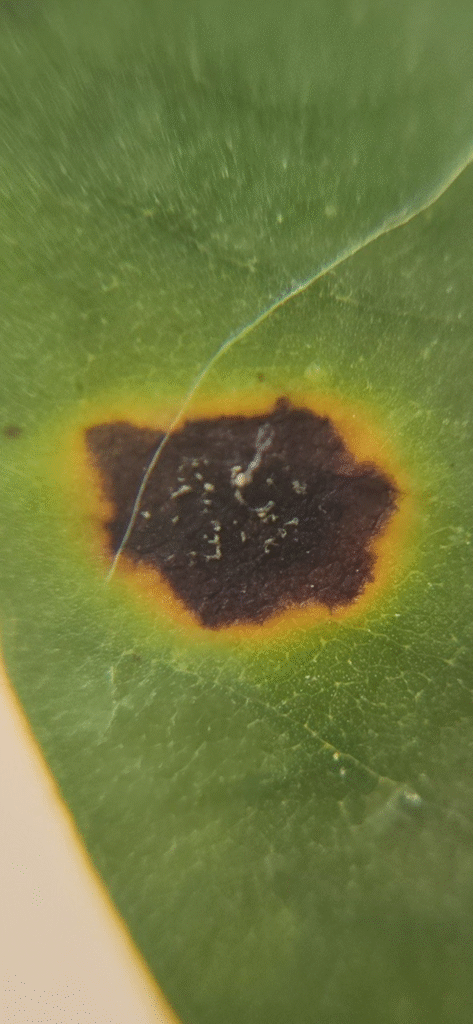
AI Is Not Always Right
Recently a grower used AI to figure out rate of foliar-applied propulse on peanuts for management of nematodes, white mold, and leaf spot. AI told him 13.6 fl oz/A on single rows (correct) but 6.8 fl oz on twins. The grower was confused and AI was confused. The truth: for foliar applied, broadcast applications, the rate is 13.6 fl oz for twins AND singles. If applied IN FURROW then the rate is split under each twin row. Take home message??? Do NOT rely on AI for important recommendations.

Chemical Burn on Peanut
Great example of chemical burn of some kind on leaf. Note “splotchy” nature. Note damage/symptoms restricted to a single even in growth of crop. Note tan, buckskin centers in the middle of spots. Burn. Not disease.
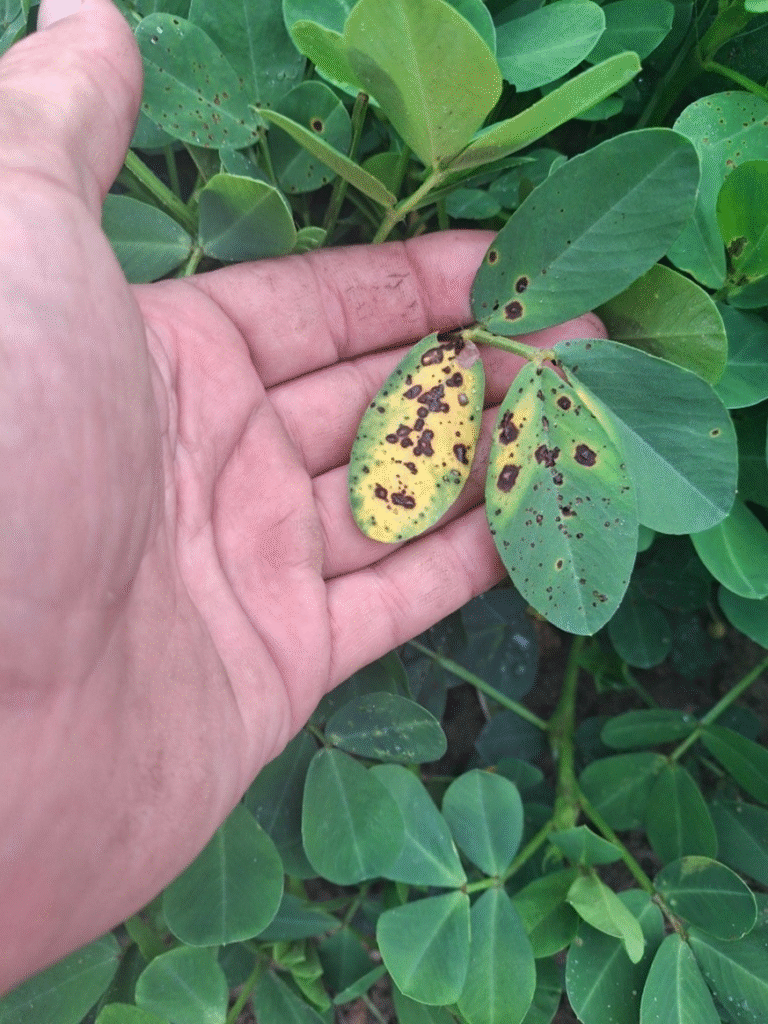
Corn Smut of Corn
This is corn smut (Ustilago maydis) which a delicacy in the cuisine from Mexico. I have prepared it many ways. I have pretended to like it many times. But truth be told, I don’t.

Late Leaf Spot of Peanut
This is late leaf spot (that showed up early….). Note the carpet of chocolate-colored spores on the underside of the leaf. Also note that while lesions associated with late leaf spot disease typically do not have a yellow halo encircling the spot, sometimes they do. Field is approaching 60 days after planting, so already there is a problem and fungicide selection becomes even more critical!
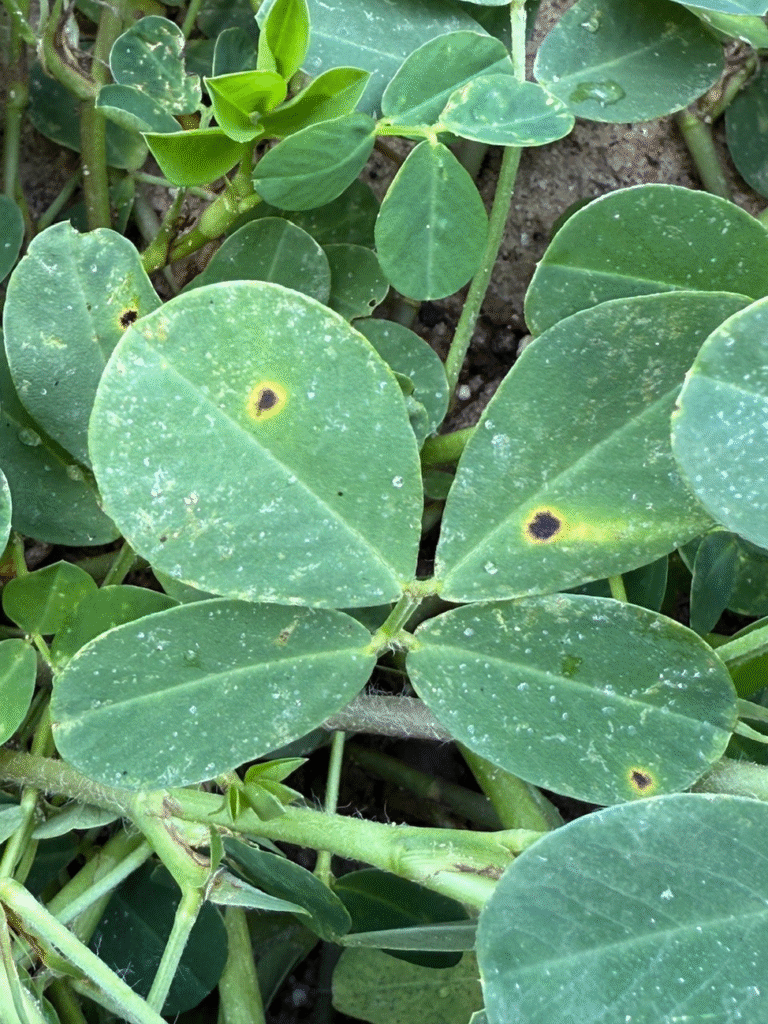
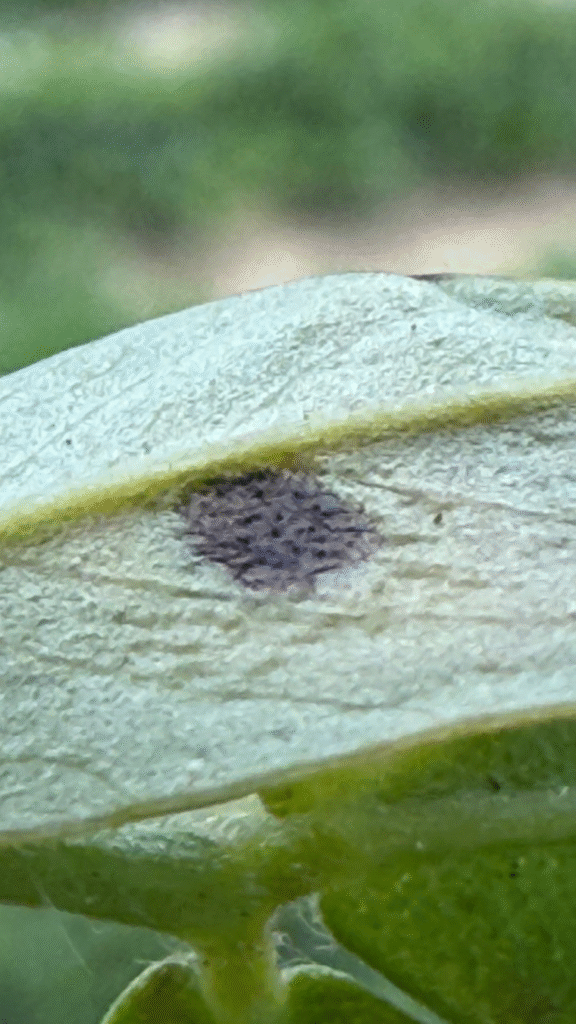
Nematodes and Fusarium Wilt of Cotton
This is a field I have been conducting cotton nematode trials in every year since 2002. The field is infested with southern root knot nematodes. For 20 years, this spot of wilted and dying seedlings was not there. For the past 3 years it appears like clockwork 3-4 weeks after planting and takes nearly every plant in the spot down. This is Fusarium wilt coupled with root-knot nematodes. The spot gets bigger every year as soil is moved in tillage and with rain. It’s not a bad thing for this field as I can test management strategies. But it IS a huge problem for cotton growers where it appears (and in Dr Hand’s and Dr Robert’s plots). To have any chance at management, growers MUST 1) diagnose the problem early, 2) seek to limit speed of infested soil to clean fields, 3) try effective management of nematodes, and 4) rotate away from cotton and other hosts susceptible to southern root-knot and sting nematodes.


Southern Corn Rust Update
Southern corn rust is on the move it has been detected in Wayne, Atkinson, and Colquitt counties in the past week.
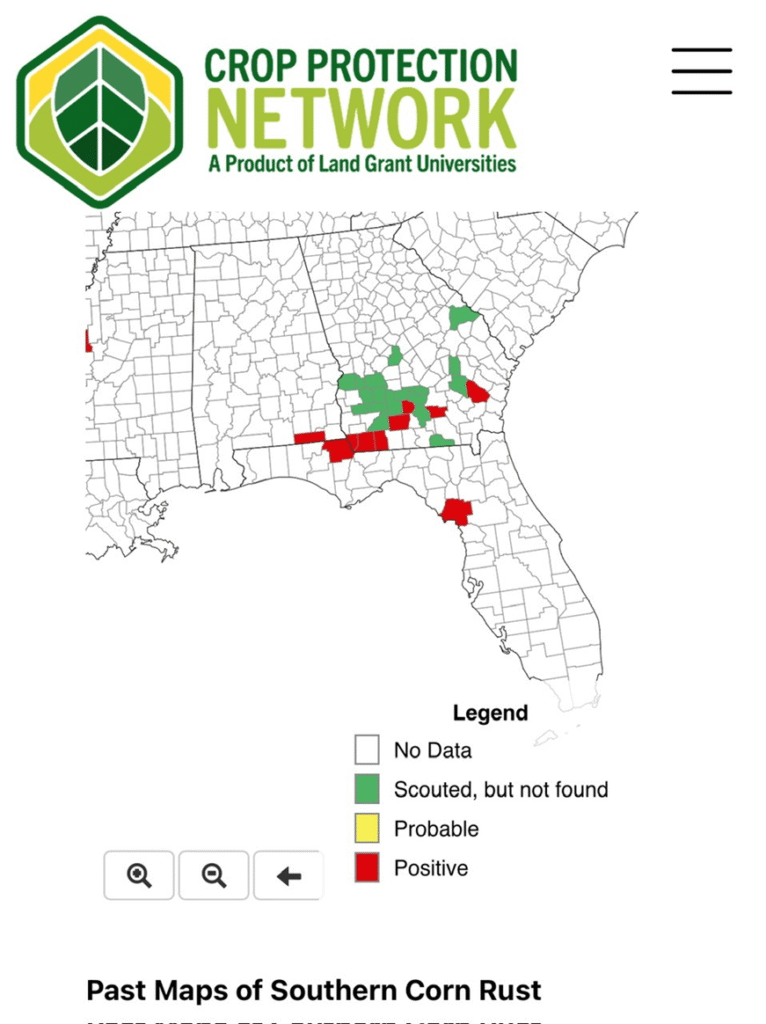
Extension Precision Ag and Irrigation Blog Posts – Dr. Wes Porter, UGA Precision Ag and Irrigation Specialist
Please find the link to this week’s blog post on Early Season Crop Water Requirements for Row Crops. If you have any further questions about this topic let us know. Thanks to Jason Mallard, Phillip Edwards and David Hall for contributing to this post.
The link to the most recent blog post can be found here: Setting Up and Using the SI Cropfit App for Irrigation Scheduling | Extension Precision Ag and Irrigation. A big thank you to Dr. Emily Bedwell, a recent UGA Crop and Soil Sciences Ph.D. graduate for all of her help with this article. It is focused on setting up the SI CropFit App. While we are a few weeks into the season there is still plenty of time to implement a sound irrigation scheduling strategy. If you have questions about setting up or using the SI Apps feel free to reach out. The CropFit now has Corn, Cotton, Peanut, Soybean, and Sweet Corn embedded in it.
Peanut Tank-Mixes – Dr. Eric Prostko, UGA Weed Specialist
A few comments about tank-mixes.
- Impossible for me to test all possible combinations of herbicides, fungicides, insecticides, adjuvants, boron and manganese.
- I cannot guarantee the complete safety of any tank-mix.
- I have attached pictures of what I have seen and tried. If not in there, I have no clue what will happen and nobody else does either. Peanut response all depends upon many factors such as time of day, temperature, humidity, health of plant, leaf wetness, adjuvants, pesticide formulation, etc. An infinite number of possible scenarios than can never be fully researched.
- Growers need to save trips over the field to save money and will likely do so as long as their crop does not die and recovers from any leaf burn.
- Not even talking about the efficacy of the fungicides or insecticides in tank-mixes since not in my wheelhouse.
- It is very hard to kill a peanut with labeled products.
More Tank-Mix Stuff
1) Here is a quick picture of a recent peanut tank-mix from JB in Wilcox Co. that was applied without a hitch. I would welcome more pictures from any County Agent of good and bad tank-mixes. If you send me a tank-mix picture, try to get planting date, application date, and picture date.

2) Here is an example why conducting meaningful tank-mix research is nearly impossible.
Grower Tank-Mix Application:

My tank-mix application of same treatment: Looks nothing like what grower saw?

3) This ain’t starting clean and no way any soil residual herbicide will work on a large, buried pigweed plants!!!! Notice buried stems/roots.

Updates to Hunters for the Hungry Program and 25-26 Deer Season – Dr. Camp Hand, UGA Cotton Agronomist
A couple of updates for you that pertain to the deer problem many producers are facing.
First – many producers are utilizing DNR’s depredation permit program this time of year to deter deer from their crops. In the last two years, there has been significant expansion efforts targeted towards the Hunters for the Hungry (HFTH) Program, particularly through investments from the state legislature. Charlie Killmaster, our state deer biologist with DNR, has worked extremely hard on this, and he has compiled a list of HFTH processors that are willing to process deer that are harvested utilizing DNR depredation permits in their crops. Some may be willing to come get the deer from the field, while others may need to meet growers or others at the processor after utilizing the DNR depredation permits, so please encourage growers to reach out to the processor if they intend to utilize these programs this summer. I would highly encourage growers to utilize the HFTH program if they are utilizing DNR Depredation Permits so the investment in the HFTH program will continue in the future. Additional info on the HFTH program can be found at this link: https://gwf.org/ghfth/
In addition to advocating heavily for the expansion of the HFTH program, Charlie Killmaster also pushed hard to add a weekend during archery season where hunters can harvest antlerless deer only but utilize a modern firearm. The DNR Advisory Board approved this addition just a few days ago. Thus, this coming up deer season, October 4-5 will be open for hunters to harvest antlerless deer only utilizing modern firearms, which is approximately two weeks early. All but 16 counties in Georgia will have this opportunity – in the attached map, if your county is in green, pink or purple, this special season is open in your county for hunters to take advantage of. Another goal associated with this single weekend during archery season being opened up for hunters to harvest antlerless deer with a firearm is to again utilize the expanded HFTH program prior to deer processors being full. The Georgia Outdoor News article related to this antlerless only weekend can be found in the following link: https://gon.com/hunting/early-gun-hunt-weekend-antlerless-deer-approved
In my opinion, these two changes are HUGE successes for both the agricultural industry along with the hunting industry, and both can be a fantastic thing for both groups if taken advantage of. I really want to thank Charlie Killmaster for his work on both of these efforts, along with Georgia Farm Bureau for pushing it in the state legislature and the state legislature for approving the funding for the expansion of the HFTH program. If you all interact regularly with members of the legislature in your counties, please thank them for their work on this matter.
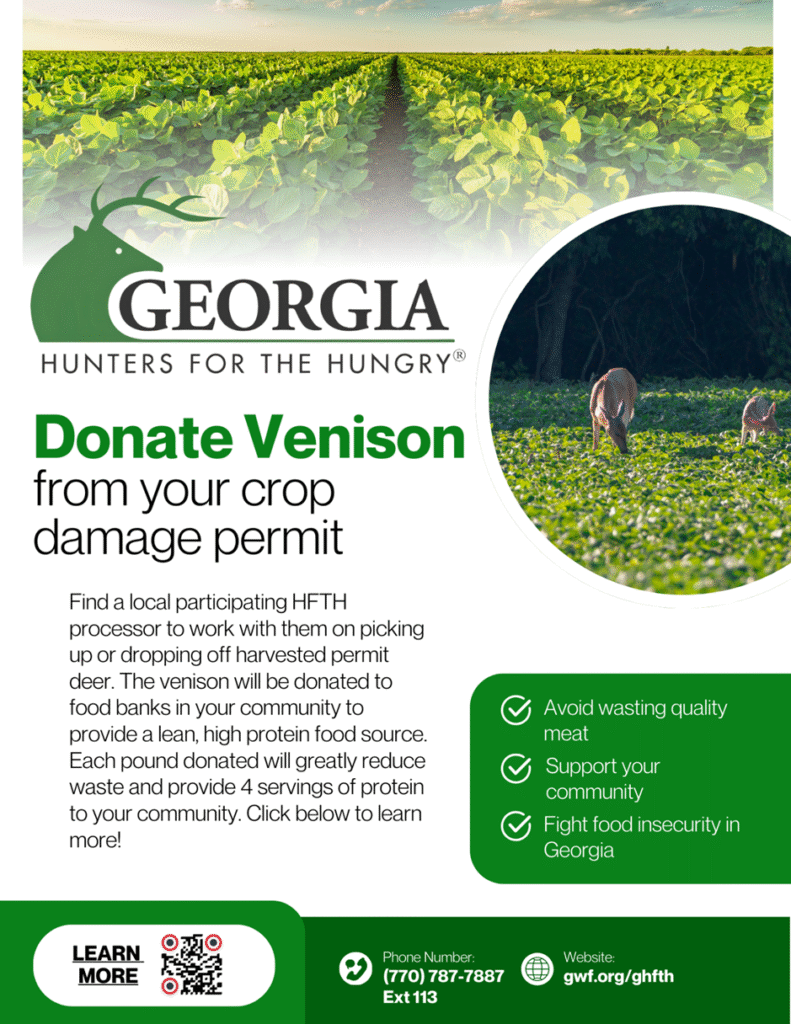
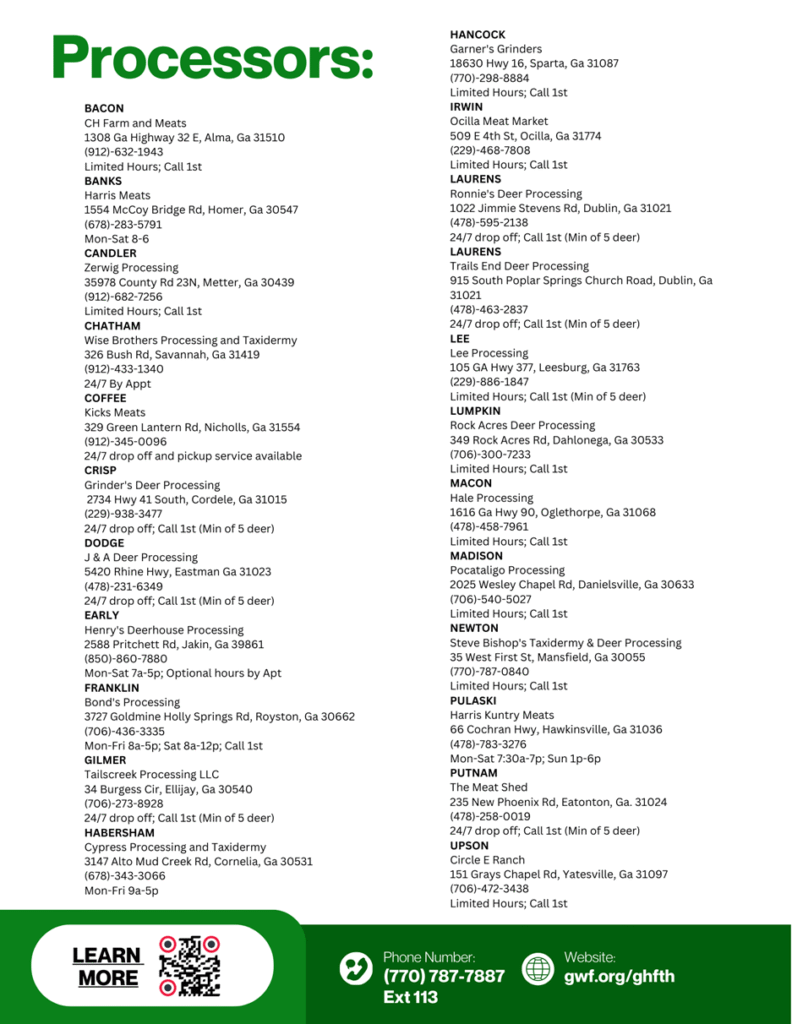
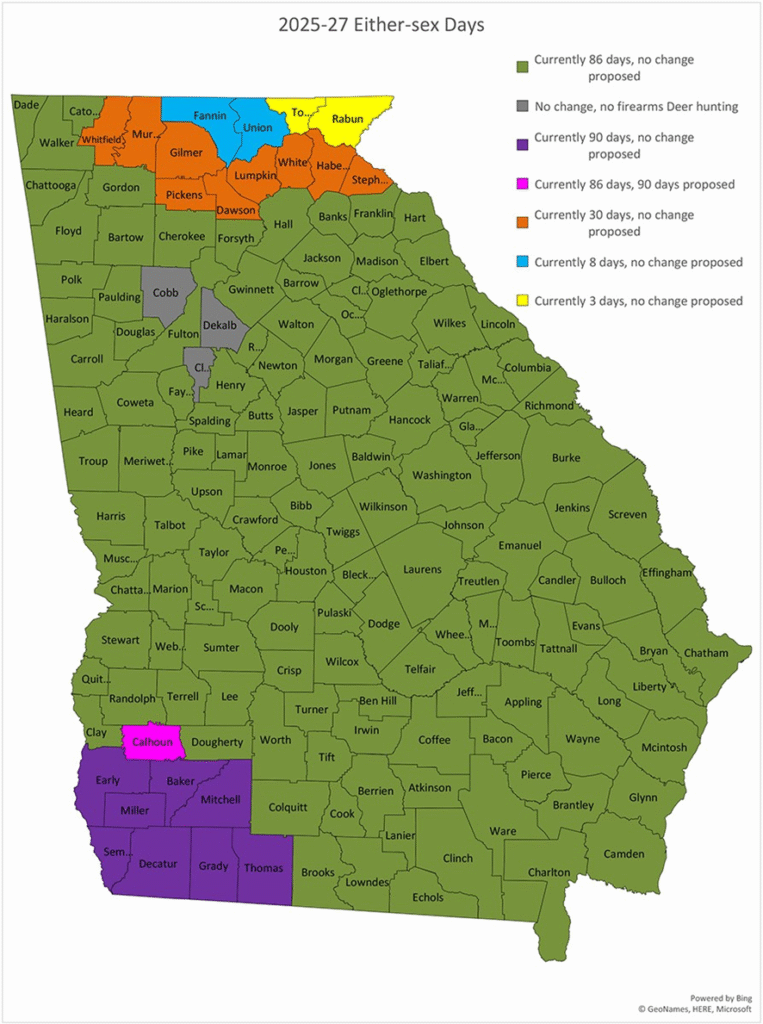
Peanut Pointers – UGA Peanut Team
All About the Pod Podcast – UGA Peanut Team

EPISODE 15, Season 3
In this episode, Drs. Scott Monfort, Mark Abney, Eric Prostko, Bob Kemerait, Wes Porter, Albert Culbreath, Tim Brenneman, and Taylor Singleton discussed the current conditions as of June 6th. Topics include stands, weed management, spray mixtures, and early-season insect and disease issues. If you would like to suggest topics for discussion on a future episode, contact your local UGA Extension agent.
EPISODE 16, Season 3
In this episode, Drs. Scott Monfort, Mark Abney, Scott Tubbs, and Eric Prostko discussed current stand issues, Calcium, pesticide mixing combination, and insect issues. If you have any questions or would like to suggest topics for discussion on a future episode, contact your local UGA Extension agent.
Go to All About the Pod News for supplemental information referred to during the podcast at: Episode 16/Season 3 Pesticide Tank Mixes | All About the Pod News
EPISODE 17, Season 3
In this episode, Drs. Scott Monfort, Mark Abney, Wes Porter, Bob Kemerait, and Eric Prostko discussed the current crop situation, and pest management. If you have any questions or would like to suggest topics for discussion on a future episode, contact your local UGA Extension agent.
Talkin’ Cotton Podcast – UGA Cotton Team
Below is a link to the latest episode of the Talkin’ Cotton Podcast. Feel free to distribute far and wide. If you have questions, other things we should be discussing on the podcast, or need anything else, please let me know.